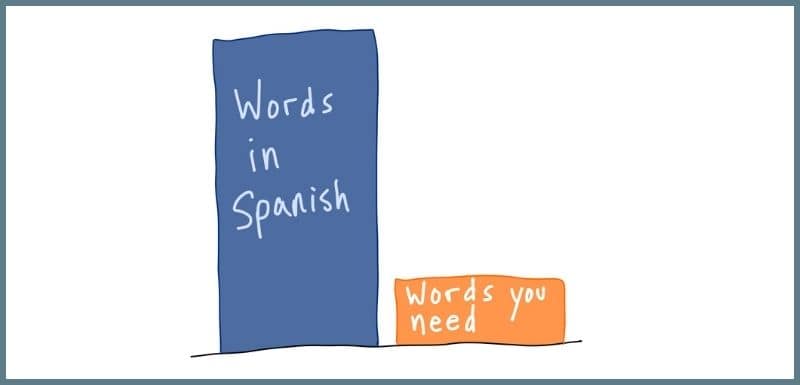There’s a mistake most learners make that keeps them frustrated.
It might be making you feel like your Spanish is worse than it is, and it’s something nearly everyone does.
Let me explain:
Picture Tom.

Tom is from Canada and his wife is from Puerto Rico. He’s been learning Spanish for a while and has reached a lower intermediate level. In an effort to improve, he tries to soak up as much Spanish as he can — reading the news, watching Netflix, listening to podcasts.
But most of it is slightly beyond comprehension. And not only that, he has the feeling that it’s not getting him any closer to having conversations with his in-laws.
He wants to participate so he can feel more like a part of the family when they get together.
But despite his efforts, he feels like a background character at dinners with her family, mind racing trying to keep up with their Spanish.
By the time he formulates a sentence in his mind, the conversation has moved on.

It’s discouraging.
Part of that is that it just takes time, and we tend to overestimate how fast it will be to speak fluently.
But the other part is obvious when you think about it: Tom has been learning things that aren’t relevant to his life.
The Spanish in the news or in Narcos isn’t relevant to conversations about his niece’s school or tomorrow’s trip to the beach.

Most of us make this mistake in our learning at some point. I definitely do sometimes.
I suspect we do this because we want to soak everything up as fast as possible. We figure, “if it’s in Spanish, I should be able to understand it.”
But there are tens of thousands of words in Spanish, most of which are not useful to your goal of having conversations with your friends, family, and neighbors.

So if it’s important to focus on what’s useful to you specifically… How do you figure out what that is?
There’s one reliable way I’ve found: journaling.
An inherent part of journaling is that it’s focused on things relevant to you. You write about your days, your goals, hopes, friends and family. You use vocabulary that pertains to your interests.
As you write, useful things pop up.
That’s because, unlike speaking, journaling gives you time to think. To consider your words, find synonyms, uncover new ways of saying things.
But if you’re like me, the lack of knowing what to write about keeps you from opening the journal in the first place.
So even though I think it’s a great idea, I haven’t done it consistently in years because of this.
That’s why I put together a list of prompts — both for you and me.
Here’s how to use them.
- First, go find a notebook if you don’t have one yet. Any will do.
- Second, pick the prompts you like and write them on the first page.
- Third, pick one for today and start writing. If you use the same prompt for several days, you may find you get better at it. That’s progress! Repetition is important.
Here are your 17 Spanish journal prompts.
Anótalos en tu diario y ponte a escribir!
“Hoy tengo ganas de…”
“El día comenzó con…”
“Al despertar, me di cuenta de que…”
“Me siento motivado/a para…”
“Hoy estoy pensando en…”
“Hoy tengo planeado…”
“Hoy me siento agradecido/a por…”
“Mi objetivo principal para hoy es…”
“No puedo dejar de pensar en…”
“La mejor parte de mi día de ayer fue…”
“Ayer, tuve una conversación con [persona] que me dejó pensando mucho sobre…”
“Uno de los momentos más memorables de ayer fue cuando…”
“Hace poco hice algo nuevo / algo que no había hecho en mucho tiempo, y fue…”
“Estoy emocionado/a por los días que vienen porque…”
“En los próximos días, tengo planeado…”
“Uno de mis mayores deseos para el futuro es…”
“Dentro del próximo año, espero que…”
As you start getting more comfortable in Spanish conversations, you’ll find yourself repeating the same words and phrases.
This gets tiresome, and writing helps.
It’s obvious you’re repeating yourself, and you’ll start looking for different ways to say the same thing.
It becomes even more powerful when you take it a step further:
Once you’ve written, it’s the perfect time to speak to yourself about the same topic. You’ve now put your thoughts together, and are as ready as you can be to talk about something.
But more on this in next week’s Saturday Spanish.
Saludos,
Connor
P.S. If you’re looking for something more, here are two ways I can help:
- Confident Spanish Pronunciation: Join dozens of motivated learners in this comprehensive, interactive course and community. It gives you the structure, strategies and training you need to speak clear, natural-sounding Spanish.
- Roadmap to Conversational: Build more confident speaking skills through real-world context and engaging conversations. Get notified first next time it opens for enrollment.

